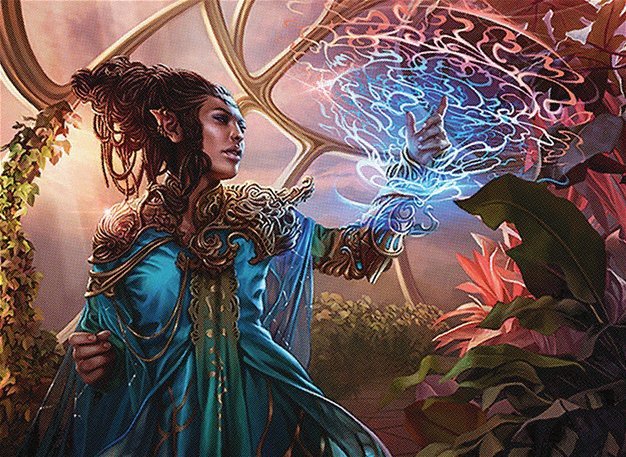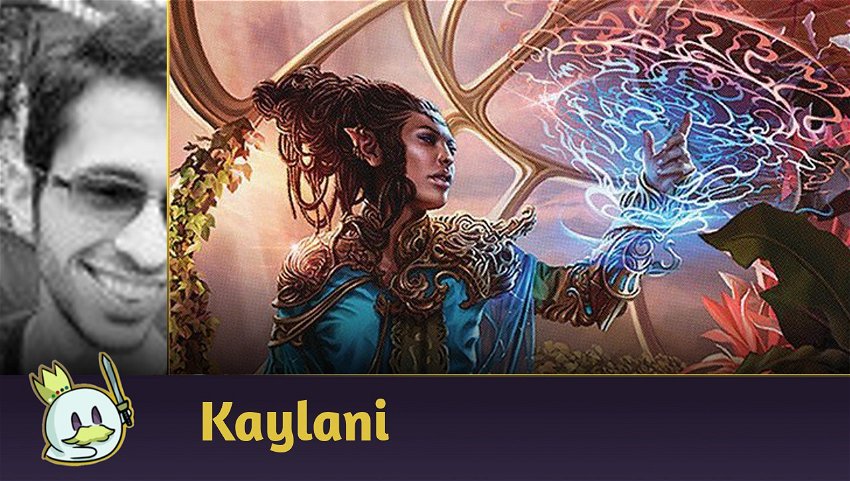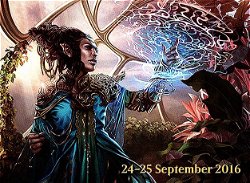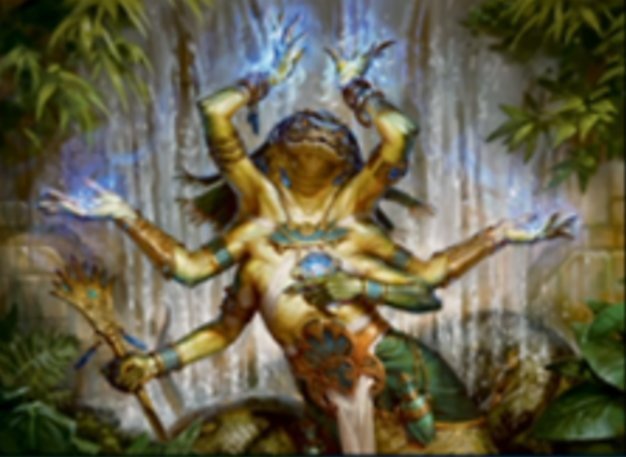
Introduction
Let's look at the second in a series of decks built with the following conditions / restrictions:
- Estimated value of US$ 30.00 at the time of creation.
- The deck should be as strong as possible and should try to win consistently when playing against other decks in the same price range.
- Basic land does not count towards the final value of the deck. Snowy terrains enter the final deck value.
- The commander's value goes into the final price of the deck.
The second deck presented is within the control archetype. A good tutorial on how to use this type of strategy can be found in the cEDH Manual series.
Disclaimer
Despite the intention of the decks presented to operate in the best possible way within the restrictions, a budget of US$ 30.00 limits the deck's capacity too much.
The proposed lists are tested against other decks in the same price range and should not be used on tables with perfectly optimized cEDH decks. We hope, however, that the deckbuilding choices presented with each list can encourage players to venture on the strongest decks of the format.
Gameplan
This deck is from the player Kaylani Bochie.
The ability of Rashmi, Eternities Crafter is a consistent source of card advantage, a vital feature for control decks.
The reduced mana cost makes the commander more attractive than alternatives like Niv-Mizzet, Parun. However, the Niv-Mizzet has compact and synergistic combos with the commander, in the form of Curiosity and Ophidian Eye. Without an obvious win condition, what can be a good victory plan for Rashmi?
Winning the Game and Building the Deck Around the Combo
The chosen combo was the classic Peregrine Drake + Deadeye Navigator.
Despite the Navigator's reasonably high cost, the combo presented itself as a more resilient option due to the almost irrelevant board state condition: some lands in the field. "Better" combos like Isochron Scepter + Dramatic Reversal need a slightly larger setup, this setup is usually trivial on optimized decks, but on slightly slower tables (with mass removals happening more often) it is preferable to use a combo that can be performed with less preparation. It is interesting to mention that the chosen combo is reasonably more resilient to removals, at the cost of a few additional mana to flicker the creatures.
Now, the combo used generates infinite mana and triggers infinite enter the battlefield effects. How to win from there if the commander does not offer an outlet for this mana like Thrasios?
The deck was built with a large number of "soft outlets". Cards like Coiling Oracle, Spectral Sailor and Read the Runes allow you to draw the entire deck after the combo is performed, but cards like Mystic Snake and [ card](Voracious Greatshark) allow you to counter all your opponents' spells (it is imperative to check the board state and whether it is possible to survive with just that). But after that, how do you win the game?
We could include something like Laboratory Maniac to really close the game, but it would be a useless card for the rest of the game and we want to minimize those choices. Therefore, the deck is built with a winconless approach, that is, it uses a super convoluted combination of cards that the deck would already rotate in any way to end the game. Perhaps the most famous deck that uses this philosophy in its construction is the The Gitrog Monster. But let's see how the combo runs from start to finish and some alternatives in the next section.
In fact, one of the common traps when looking at a commander who casts spells from the top of the deck is to include cards that synergize with this effect, but that are not necessarily good, like Future Sight and Magus of the Future.
Naturally, having this effect on the field together with Rashmi is very strong, but casting a spell with converted mana cost equal to five and passing the turn is not exactly what this deck wants to do. This deck also does not usually do well when it presents itself as the threat of the table.
Combo Lines

Initial condition: lands in the field generating 8 mana (or less depending on some conditions that I mention in the relevant items). Drake + Navigator + some outlet on hand.
- Cast Peregrine Drake and on the ETB untap 5 lands. Note: if any land generates more than 1 mana, this step generates mana and the initial mana condition is reduced.
- Cast Deadeye Navigator and on the ETB pair with Drake.
- Pay 1U and flicker the two creatures to untap 5 lands.
Ideally, it will be possible to draw the deck with one of the outlets. If this is not possible, Mystic Snake and Voracious Greatshark can counter all next spells until an outlet is found. It is worth noting that the combo must be executed on each opponent's turn and then flicker Snake and Greatshark, but it is good to pair the Navigator back with Drake at the end. If the counters are on hand, we can also take 3 Rashmi triggers in one turn rotation. But what about when we find the outlet? Let's see how to loop any spell (we will use bounces to remove opponents' permanents and a pump spell to win with combat damage). The magic to be looped in the example will be Into the Roil.

- Draw the deck with an outlet. Whether flickering Coiling Oracle or activating Spectral Sailor.
- Cast Into the Roil.
- Cast Skullwinder. At ETB, return Roil to hand and pair with the Navigator.
- Cast Into the Roil.
- Flicker Skullwinder with the Navigator and repeat from the previous step.
After that we can use a Reclaim to put the graveyard back on the deck and pass the turn. With the ability to execute the combo at instant speed, our opponents will not be able to override all of the deck's responses. On our next turn the combo is run again to loop a pump spell like Simic Charm and win by attacking.
The mana cost of the combo is extremely high, so the deck usually goes to the late game, where the quality of the deck's cards, associated with the card advantage, makes him quite capable of holding the game until it's time to finish.
Shared Summons

The Shared Summons card draws attention by tutoring the two pieces of the combo at instant speed (and this deck always tries to play at instant speed to maximize the number of Rashmi triggers). Although it costs 5 mana, as the combo costs more than that, it is a great tutor for the deck.
How to Defeat
The deck relies a lot on the commander, so it is necessary to keep Rashmi in check. In addition to trying to break the control pilot's card advantage engine, it is also important to have instant speed interaction for the combo.
Creature removals, especially exile effects, are good for combating the combo. It is also important to weigh which cards can be played with a low probability of being answered. The control player will not spend his response on any small action from his opponents, but trying to force a play that will end the game when the control player has 6 mana standing will not catch on well. You need to wait / force better opportunities to deploy your best cards.
Card Discussion
Alternative Combo Pieces

If the Drake is inaccessible, the combo can be performed with Cloud of Faries and Simic Growth Chamber in place.
If the Navigator is inaccessible, the combo can be performed with Skullwinder and Ghostly Flicker in place. This variation requires an additional outlet.
You can see that all roads lead to Skullwinder. If there is any fear of winning without Skullwinder you can include a Archeomancer in the deck. However, I preferred not to spend another slot and try to force victory with only half the deck in hand and attacking if that happens. You have to weigh how much redundancy is going to be stuck in your hand compared to how many matches you should lose because your wincon has been exiled.
Ramp

The deck runs a very varied composition of ramp pieces. Those that cost less than 2 aim to speed up Rashmi in one turn The heaviest ones are usually in instants to maximize the number of Rashmi triggers and always pass the turns with open mana.
Interaction

Most varied responses and with a lower curve. With the exception of soft outlets and Baral's Expertise which acts as a curve topper, it is to reset immediate threats on high decks.
Mulligan Guide
Perfect Hand

Perfect is a strong word, but you can see that an ideal hand is one that ramps on the correct curve and stabilizes with Rashmi before turn 4 with some play to draw cards soon after.
Acceptable Hand

A slightly less explosive hand with slightly worse ramps. But it is a hand that casts the commander earlier and has interaction + card selection.
Bad Hand

Nothing to cast, right? Waiting to go cast lands to have acess to blue mana is terrible. The hand is almost acceptable if you draw a blue mana, but it's not worth it. Mulligan.
Conclusion
You need to know the metagame
Playing Control is extremely delicate in a multiplayer environment. The control player loses games because he used his answer on the wrong threats. Approach tables carefully and abuse priority mechanisms to preserve your interactions. Try to maximize the number of Rashmi triggers.
Strengths
The deck stabilizes in the midgame and holds up well until the late game. The combo can be tutored with just one card and the quality of cards in the rest of the deck is quite high. He can operate almost like a pillow fort and interact only when necessary, waiting for the perfect time to end the game. The budget cap made interactions very varied and difficult to read. This means that those classic readings like "1 blue mana open= Swan Song / Flusterstorm / Dispel, so I can cast my creature without fear" do not work for opponents, after all, who expects a Out of Bounds?
Weaknesses
The commander acting as the main card advantage engine means that the pilot needs to spend resources trying to protect her. Medium decks, which pose light threats gradually can overload the deck. Decks with a large presence in the field can also end up passing by the interactions, since there is no key point with which the Rashmi pilot must interact. This list usually stabilizes on 4/5 turns, before that the plan is very linear: ramp and cast the commander.
This ends the second article in the series.
I will be back soon with another budget deck in a new archetype ...















— Comments 0
, Reactions 1
Be the first to comment